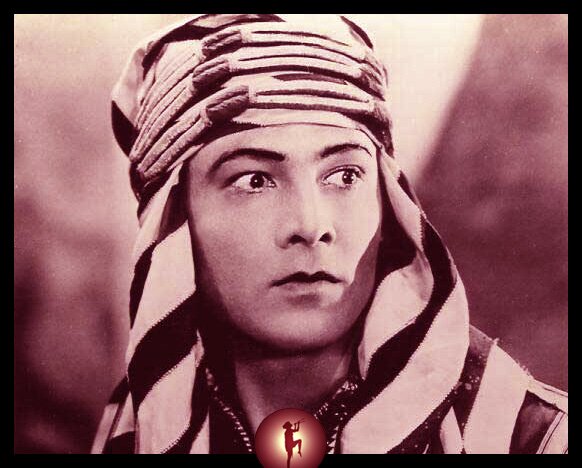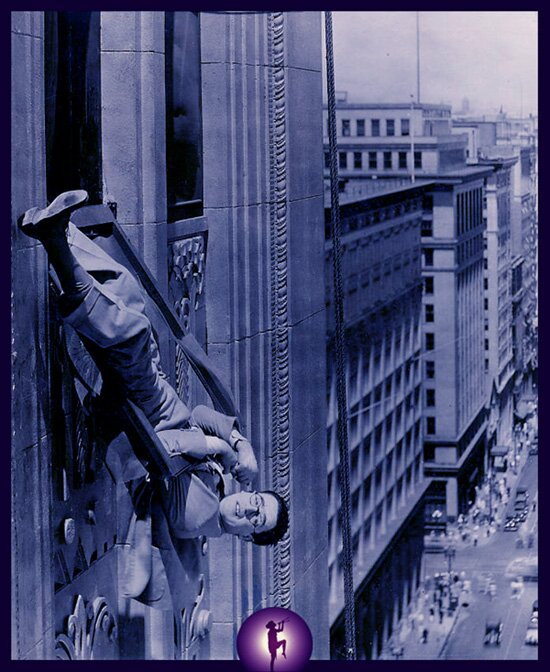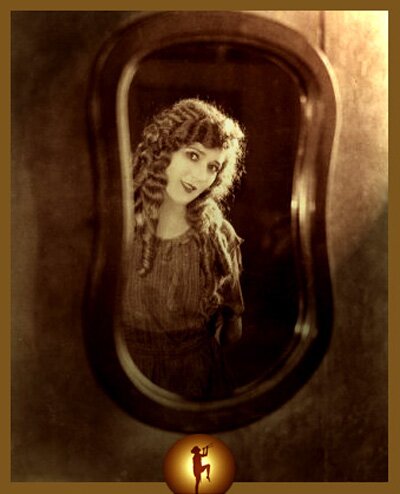|
November 01, 2006 The 3 Ages of My Silent Cinema Journey Part One: The Dark Age I have often contemplated the evolution of the venues through which we come to know the Silent Cinema and its stars. For there was a time not very long after the close of the Silent Era when a nexus to the silents was very difficult if not impossible to find. It was at that time I began my journey to the Silent Cinema. There was very little available information on the subject and even fewer films available for viewing. Nevertheless I steadfastly pressed on... As my cinematic odyssey progressed more information on the silents eventually became available, thus enabling me to travel farther backward and thereby gain a clearer perspective. I have now identified 3 different ages of my Silent Cinema journey, each created by the filters of the evolving venues—and my backward temporal approach reminds me a bit of the life of Merlin who lived his years in reverse... When I was quite young the silents seemed to be quite old—even though they really weren't that far in the past. There were many people around who remembered them firsthand and some of the silent stars were still making public appearances. Ironically I came to know the silents better as they became more temporally distant. And now they seem more immediate to me than ever before. They no longer hold nearly the same degree of mystery as they once did but the wonder still remains. And I believe that wonder was and still is an integral component of the silent era. It is something the movies seem to have lost along the way—and sadly I believe audiences have lost it as well. I had very few opportunities to view silent films when I first became familiar with the stars of the era. However I saw pictures of the stars in books and I read about them. At that time it seemed that each was summed up by a pithy yet momentous phrase. Mary Pickford was "America's Sweetheart," Chaplin was "The Little Tramp" and so on. It was probably assumed that the target readership audience was largely made up of people who had seen the stars on the silent screen and remembered them. I, however, was a reader who had never seen the stars on the silent screen. And as I was just getting to know them for the first time, the summations in the books left a great deal to the imagination. "America's Sweetheart" didn't tell me much about Mary Pickford's screen character except that she was apparently quite popular. In fact I didn't find any of the written descriptions of the stars to be very illuminating. So I turned to the pictures that were reprinted in the books. I remember one photograph of Mary Pickford that looked like it had been taken at the dawn of time. The image intrigued me and I even found it to be a bit haunting but it didn't tell me much about her mysterious screen image. Rudolph Valentino was "The Great Lover." He was typically shown with a woman in his arms and an expression of exaggerated seriousness in his eyes. Such images gave the impression that his acting had been way over the top. We know now that wasn't the reality but that is the type of still they would reprint—something to make the star look like a caricature. And together with the pithy summations the silent players became one-dimensional cardboard cutouts. This treatment of the silent stars was reflected on the screen as well in films such as SINGIN' IN THE RAIN, which I will write about later on.
Rudolph Valentino as I first knew him.Another cardboard cutout was "The Vamp." Theda Bara was usually shown as Cleopatra in a pose similar to those depicted in typical Ancient Egyptian drawings. Wow! Theda seemed to exude appeal and terror simultaneously. It wasn't surprising to discover that she had once been the intriguingly exotic vamp who led men to their demise as they blissfully fell at her feet. It is interesting to note that Theda was one of the few silent stars who was always pictured; other stars who were popular at about the same time such as Pearl White were frequently omitted. In fact I don't recall seeing Pearl White in the books I had access to—but I do remember how I first heard of her. THE PERILS OF PAULINE with Betty Hutton was shown on television late one night when I was in the first grade. I was not able to stay up late to watch it but my father viewed the film for me. He told me all about it the next day at lunchtime. I was most interested in the scene where Betty was shown in a rapid succession of clips that depicted the various perils Pearl White had endured on the screen. That afternoon I went back to the classroom thinking about Pauline being tied to the train track and wondering how she ever managed to free herself before the oncoming train arrived... Unfortunately survival techniques of this sort were never part of my school's curriculum. And it would be decades before I would see either the Pearl White or Betty Hutton version of THE PERILS for myself. Buster Keaton was "The Great Stone Face." The books gave the impression that Keaton never smiled on screen, which was true—but only after a certain point very early in his career. Keaton had supposedly been a great comedian but somehow this assessment was not substantiated by the title "Great Stone Face." I didn't see anything very funny about a Great Stone Face. What kind of a comedian didn't smile anyway? ...Ah, the mysteries of the silents. William S. Hart didn't seem to smile much either—at least not in the stills I saw. Nobody ever would have called him "Smiling Billy" Hart. He was the two-fisted gunman who feared nothing and made westerns that were suitable for adults rather than children—whatever that meant. He was usually shown holding several men at bay, all of whom had their hands up. Or he was shown playing cards. His films looked like they were great fun but I couldn't understand why a man holding up a group of men was not suitable for children. It seemed quite suitable to me. Later on I decided the authors were probably trying to say that Hart's films were more serious than the old Roy Rogers westerns had been. But after a point it no longer mattered what the authors had been trying to say. Lon Chaney was "The Man of a Thousand Faces." How could any man have a thousand faces? I doubted that Chaney had made anywhere near a thousand films so where did all of those faces come from? The lesson here was that authors during and after the silent era tended to use hyperbole to describe the larger-than-life screen personas of the stars—and it is a point that is frequently overlooked today. There was even a claim that Lon Chaney had filed his teeth for his role in LONDON AFTER MIDNIGHT. That was a little hard to believe... And the most often repeated story was the one about the many women who had fainted when Chaney was unmasked in PHANTOM OF THE OPERA. Every time I see the unmasking sequence I am reminded of those women fainting. When I worked at the cinema several years ago I did indeed witness women fainting at the sight of a gruesome scene. I'll write about that later on but for now I just want to confirm that the Phantom fainting story is quite plausible. Harold Lloyd was the third comedian, presumably not as funny as Chaplin and Keaton—even though that was not the reality. He was forever scaling buildings and hanging from a clock, which was also not the reality. It seems hard to believe today but this was the only Harold Lloyd some of us knew for years. Who wanted to see a comedian hang off of ledges and such through film after film? Nothing seemed very funny about that—no wonder he was in third place. Lloyd's "all-American young man" image never came through in those books. He was just the guy who wore glasses and hung from the clock.
The only Harold Lloyd I knew for years.Now Douglas Fairbanks didn't hang off of buildings—he jumped off of them. And he usually jumped off only to land in a speeding car. And when he wasn't jumping off buildings he was climbing up them. I had the advantage of actually seeing a few clips from a couple of his early films and this is the impression I was left with. The books always showed Doug in one of his costume pictures, however—usually THE THREE MUSKETEERS. It was difficult to imagine what his early films (in their entirety) had been like based on the clips I had seen—but they sure must have been something. Didn't he ever stop jumping around—at least to eat? Another star in constant motion was "The It Girl." Clara Bow was the totally wild and out of control flapper who flaunted conventions like they were yesterday's dailies. She sure didn't look like she was made of cardboard but she was nevertheless presented in one dimension. Today I am amazed that anybody would have attempted to limit the scope of Clara's animated image to one cardboard facet of her screen persona but that is what they did—she was the "It Girl." Just like the rest of the silent stars she was transformed into a paper doll—but what a doll she was. Norma Talmadge and Colleen Moore were lucky to get a mention in any of the books I managed to get a hold of. Norma had been some sort of heroine but I never really figured out what sort she was. As for Colleen she wasn't presented as a flapper. Clara Bow already held that title and apparently there hadn't been room for more than one flapper on the screen at the same time. So Colleen was presented as the girl-next-door. And that is exactly who she was—provided you were fortunate enough to live in her neighborhood. Although most of the other stars were typically not mentioned by name, the books usually did acknowledge the existence of supposedly "lesser" players in general terms. It had all happened so long ago that nobody really cared very much about who they were anymore. Last but certainly not least were the stars whose names were deliberately omitted from the books. I am able to identify two such stars, the first of which is Roscoe "Fatty" Arbuckle. As it turned out I was aware of Fatty Arbuckle because I had seen him in FATTY AND MABEL ADRIFT. But when I began to look at the books I discovered that Fatty no longer seemed to exist. I was puzzled by this and so I asked my father why Arbuckle was missing. He told me about the scandal that had ruined Fatty's career—and it was then I discovered that Arbuckle's name had been taboo for years. I began to realize the books were not necessarily revealing the whole story and wondered who else they weren't telling us about... Some time later I discovered the other star who had been deliberately ignored for decades. I hadn't known she existed because I had never seen any of her films and I certainly wasn't going to find a mention of her in the books. However I did eventually discover Marion Davies and the reason her name had been taboo for so long. It was because of her involvement with William Randolph Hearst. To make matters worse people had blindly "learned" she had no talent from the Susan Alexander character in CITIZEN KANE. Of course we now know that Marion had a great deal of talent. So I guess we can't believe everything we see in the movies. And that was the history of the Silent Cinema as I first knew it. I now know there were actually some good books on the subject available at that time—but I didn't discover them until later on. The books I did read, however, did not provide the optimal venue for getting to know the silent stars because the Silent Cinema didn't translate well into one static dimension. The silence remained but the motion had been removed from the once moving picture. And the silent stars I knew were barely shadows of the shadows that had once illuminated the silent screen. The color was gone, the music was gone and the movement was gone. We were left with only the images of their glorious faces and the text that usually did them a disservice.
Mary Pickford... through a glass darklyAs I looked through the glass darkly there was much I couldn't see. I couldn't see Mary Pickford holding her arms before her with fluttering fingers as she anticipated some exciting event that was about to unfold. Nor could I make out Doug Fairbanks as he flung his arms open wide and proclaimed via intertitle, "I'm the happiest man in the world!" when his girl finally said yes. I couldn't see Garbo telling us what was on her mind with a slow flash of her eyelids and the underplayed hint of a smile. Or Clara Bow doing her little half dance from a seated position as she began moving with a flirtatious rhythm. I couldn't make out Keaton stolidly escaping one close call after another as each solution conveniently appeared at just the right moment. Or Chaplin sliding on one foot with the other leg in the air as he turned a corner while being pursued... The Silent Cinema I first knew was far different from what it once had been—and from what it is now. It was as temporally far removed from the original era as it is from today. It was a cinema that was void of motion—for the still image had replaced the moving as celluloid morphed to paper. The original Silent Cinema had seemingly been dismissed with condescension when it should have been wrapped in tissue paper with care. We were left with a bygone era that had taken its place beside the other bygone eras whose time had passed. And what remained comprised the only Silent Cinema I knew in the beginning of my journey to the heart of the silents. It was a dark age indeed. |
|
|



